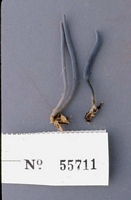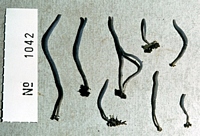|
 Clavaria musculospinosa Clavaria musculospinosa
BiostatusPresent in region - Indigenous. Endemic
Images (click to enlarge)
Caption: Fig. 28 Clavaria musculo-spinosa. TENN no. 43541. Scale bar = 5 µm. | 
Caption: Microfiche 1-21. Clavaria musculo-spinosa. TENN no. 43540. | 
Caption: 1042, id. R. Petersen, label 50x10mm, NZ, NI, Orere, Te Morehue, on soil among litter under
Leptospermum-Knightia-Suttonia, 04.07.1981, leg. EH
Owner: E. Horak |
Article: Petersen, R.H. (1988). The clavarioid fungi of New Zealand. New Zealand Department of Scientific and Industrial Research, Bulletin 236: 170 pp. Wellington:.
Description: Fruit bodies up to 60 x 4 mm, simple clubs, solitary to cespitose in groups of 2-3, arising
from a small, whitish mycelial patch. Stipe equal, pallid at base ("tileul buff") grey above
("pale neutral-grey"), appearing silky. Club matte on surface, equal, often somewhat
wrinkled or subsulcate, grey to bluish grey ["neutral-grey", "7 grey" "deep dull grey", "deep
plumbeus", "mouse-grey"]; flesh more deeply coloured than hymenium outward, paler and
more fibrous or stuffed within. Apex rounded. Taste and odour negligible.
Macrochemical reaction: FCL = negative.
Tramal hyphae of club 3-20 µm diam., hyaline, unclamped, thin-walled, strictly parallel,
covered with small patches of amorphous material, and with occasional crystals.
Subhymenium extensive, pseudoparenchymatous. Hymenium thickening; basidia 70-80 x
10-13 µm, broadly clavate, bifurcate or clamped at base, more or less persistent after spore
discharge; contents granular to multiguttulate at maturity; sterigmata (2-3)-4, stout, arising as
rounded lobes, eventually up to 10 µm long, curved-ascending.
Spores (Fig. 28) 9.4-11.2 x 7.9-9.0 µm (E = 1.08-1.41; Em = 1.21; Lm = 10.3 µm), broadly
ellipsoid, conspicuously roughened; contents multiguttulate to uniguttulate; hilar appendix
broad, papillate; ornamentation of narrowly truncate-conical spines up to 1.5 µm long.
Notes: Again, spore ornamentation provides a most confusing situation. Clavaria ardosiaca not
only shares almost identical fruit bodies (colour, stature, etc.) but unusually large spores,
however, its spores are smooth. At the same time, C. musculo-spinosa specimens vary
greatly in this character, for TENN no. 43541 and Horak's collections show almost no
smooth spores, whereas TENN no. 43540 shows very few ornamented spores. Were the
rough spores not seen on TENN no. 43541, it would surely have been accessioned under C.
ardosiaca. Thus, although it would appear that species pairs exist - one with ornamented
spores, the other with smooth-this maybe artifactual, really representing a cline under
unknown controls.
The wide, long basidia are a reflection of the large spores. Sterigmata number is very
variable, perhaps (as in many other taxa) related to the unusual variation in spore dimensions
and E values. Sterigmata are blunt until near maturity.
|